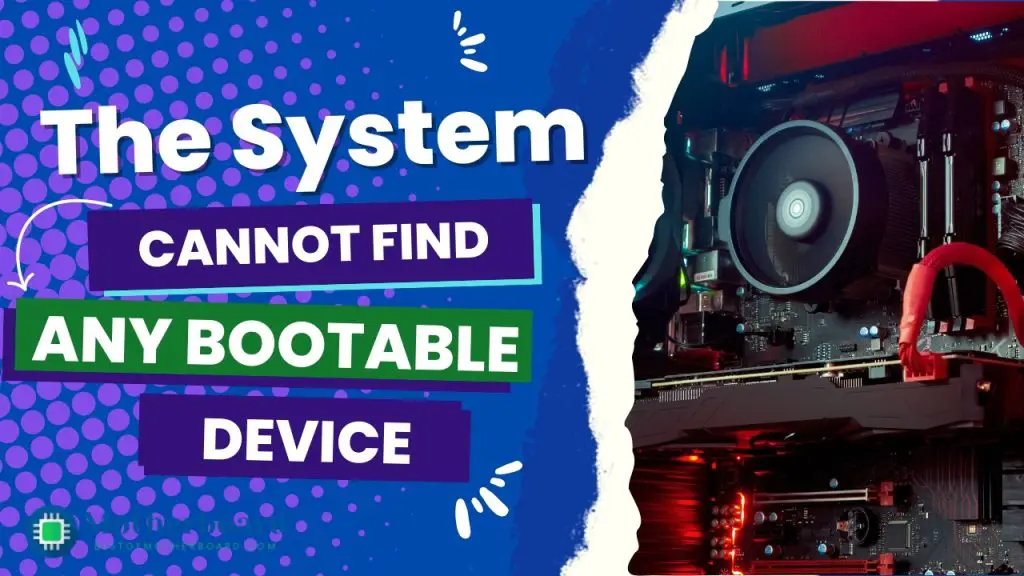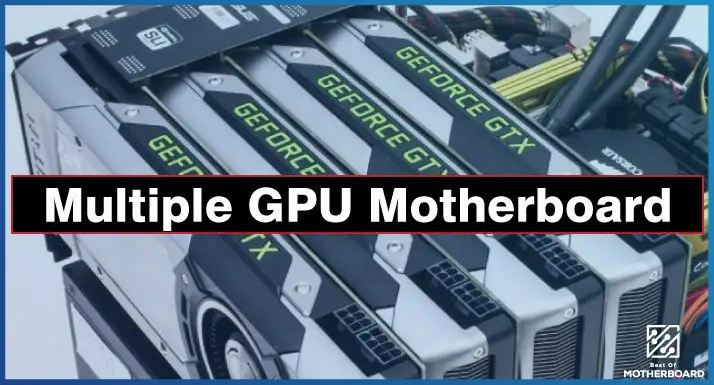“System cannot find any bootable device” is a boot error message you’d get when there is a problem with your hard drive, whether it is legacy or UEFI. While there are a few other causes for this error, the best solution is to turn on legacy boot mode if the SSD is from an older system.
If that doesn’t work, then the reason for the error could be more technical than it seems. You will need to focus on other fixes like reconnecting the required components, changing the boot order in the BIOS settings, checking the internal hard disk status, fixing the boot information of your system, or even installing a new operating system.
“No boot device found” is a common problem, especially in Asus, HP, and Dell motherboard setups. When I finished my first build and couldn’t get Windows to boot, I ran into this issue. I had to do more profound research on ways to fix the problem.
In the rest of this post, you will see—in detail—the best, quick, and easy ways to fix the “No bootable devices found” error message.
Let’s start with the actual causes.
Other Causes of “The System Cannot Find Any Bootable Devices” Error Message.
There are three main reasons you see this error message when you start your computer on the motherboard. It is either:
- The bootable device is disconnected from your PC.
- You have more than one hard drive on your PC.
- Or simply, your computer is struggling to recognize which drive to select while booting.
The right fix that will save you hours of anguish is determined by what you identify as the cause and the motherboard brand. But these eight solutions will work for any brand’s new and old motherboards.
8 Fixes For the “No Bootable Device” Error on Any Motherboard Brand
- The first fix that works most of the time is to start your computer and then press and hold CTRL + ALT + DELETE. Make sure you press these keys simultaneously as the system boots, and don’t let go until the display appears.
- If that doesn’t work, consider starting the computer and punching the F12 button as it boots. This will launch you to the boot manager settings, where you should select all Windows boot managers and then observe the result.
- Another way to solve the issue is to restore the default BIOS settings. When you press the power button to start the computer, keep pressing the delete button to gain BIOS access. Once on the page, navigate to “Save & Exit” and select “Load Optimized Defaults.” Then you click on Save and Exit Setup to observe the result. Your computer’s windows should be on display by now.
- If you still get the same error message, you may want to try resetting your computer’s boot priorities. To do this, start your computer and press the Delete button to access the BIOS. Once you’re on the page, navigate to “BIOS,” click on “Hard Drive DSS Properties,” the best option for the device, and then save and exit to observe the result.
- The problem could be due to some BIOS setting you don’t know about. So alternatively, you can reset all the BIOS settings and see if it works. To do this, unplug the power cable, open the left-side cover of your CPU, and then remove the CMOS battery (which looks like a silver coin).
Afterwards, press and hold the power button for 5 seconds, re-insert the battery, assemble the setup, and try booting to observe the result.
- When you get the “No bootable device found” opening error message, there could be a connection problem with the SATA cable. So consider unplugging the power cable, opening the front cover of your CPU, reconnecting, and inspecting the power/SATA cable.
Also, give the ports a proper clean using a soft brush, assemble the setup and try again. If nothing changes, consider replacing the SATA cable.
- Another way to resolve this error message, which could be a game changer, is to replace the new HDD or SSD with the installed OS. This should be the last resort if you have tried all the above fixes. By changing the OS, the computer will boot without such error problems.
- Unplug any USB devices on your computer. Unplug UBS hubs, printer plugs, or external drives and try rebooting to see if the problem is resolved.
Now, let’s give special attention to addressing this error message on a particular motherboard brand.
“No bootable device found” solution for HP motherboard brand
To resolve the “no bootable device found” problem in HP computers, you must forcefully shut down the system by pressing the power button for 10 seconds, then wait 2 seconds before pressing the power button again.
As the system attempts to boot, continuously press the F10 button to bring on the BIOS setup. In the BIOS setup, search for “System Configuration.” Then go to the boot option and find “Legacy Support.”
Please enable it and save the setting by pressing the F10 button. You will observe that Windows will boot up without showing the “no bootable device found” problem.
“No bootable device found” solution for the Dell motherboard brand
Suppose the “no bootable device found” error message appears on your Dell motherboard computer. In that case, it means the computer cannot gain access to the HDD or SSD containing its boot information or that it scanned all the connected HDD and SDD for boot information without finding any.
To solve the issue, start the computer and press the F2 key for the setup utility, which will bring up your BIOS setup settings.
On this page, navigate the boot sequence, where the Legacy mode and UEFI mode lists are visible. You may observe that the UEFI boot section in the boot sequence does not show any hard drive.
To fix the problem, check which boot options you have selected—legacy mode or UEFI mode—and then choose the one your system supports. Then click the apply button and save the settings.
By clicking exit, your computer will restart, and you won’t see the error message again.
Gigabyte No Bootable Device Found
The error message “No bootable device found” means that your computer cannot find a bootable device to start from. This can happen for a number of reasons, such as:
- The hard drive or SSD is not properly connected.
- The hard drive or SSD is not detected by the BIOS.
- The hard drive or SSD is not formatted correctly.
- The operating system is corrupted.
- The BIOS settings are incorrect.
To fix the error message “No bootable device found”, you can try the following:
- Check the connections to the hard drive or SSD. Make sure that the cables are properly connected to the motherboard and the power supply.
- Enter the BIOS and check the boot order. Make sure that the hard drive or SSD is listed as the first boot device.
- Format the hard drive or SSD. This will erase all data on the drive, so make sure to back up any important files first.
- Reinstall the operating system. This will restore the operating system to its original state.
- Update the BIOS. This may fix any bugs or errors in the BIOS that are causing the problem.
If you have tried all of these things and you are still getting the error message “No bootable device found”, you may need to take your computer to a professional for help.
Here are some additional things to check if you are getting the error message “No bootable device found”:
- Make sure that the BIOS is set to the correct boot mode. For example, if your hard drive is using the GPT partition table, you need to make sure that the BIOS is set to UEFI boot mode.
- Check the boot priority in the BIOS. Make sure that the hard drive or SSD is listed as the first boot device.
- Try clearing the CMOS. This will reset the BIOS to its default settings.
- If you have a USB drive with the operating system installed, you can try booting from the USB drive.
Asus Bios Utility EZ Mode No Bootable Device
The error message “ASUS BIOS Utility EZ Mode – No Bootable Device” indicates that your Asus computer’s BIOS (Basic Input/Output System) is unable to detect a bootable device, such as a hard drive or SSD.
Possible causes of this issue include:
- Incorrect boot order settings in the BIOS.
- A faulty or disconnected data cable between the storage device and the motherboard.
- Malfunctioning or improperly installed storage device.
- Corrupted or missing operating system files.
Here are some potential fixes to address the issue:
- Check the boot order: Access the BIOS settings and ensure that the storage device containing the operating system is listed as the first boot option.
- Verify connections: Make sure the data cables connecting the storage device to the motherboard are securely connected on both ends.
- Test the storage device: Try connecting the storage device to another computer or using a different storage device to see if the problem lies with the device itself.
- Reinstall the operating system: If the issue persists, you may need to reinstall the operating system on the storage device to fix any corrupted or missing files.
If none of these solutions resolve the problem, it’s recommended to seek assistance from ASUS customer support or a professional technician, as there may be more complex hardware or software issues at play.
Final thoughts
No matter what might be causing the “no bootable device found” error message to appear on your screen each time you try booting the computer; the solution is not far from either reconnecting the required components, changing Boot Order from BIOS settings, checking the internal hard disk status, or fixing boot information for your system.
Specific motherboard brands may have a slightly different approach to resolving this error message, but changing the boot order from the BIOS setting appears to be the comprehensive solution.
Let me know in the comments which of these fixes eventually worked for you. And if you found this helpful, you can share it with a friend.



![What Are Motherboard Standoffs? [Guide] 4 What Are Motherboard Standoffs](https://bestofmotherboard.com/wp-content/uploads/2022/01/What-Are-Motherboard-Standoffs.jpg)
![Does it Matter Which PCIe x16 slot I Use? [Guide] 5 Does it Matter Which PCIe x16 slot I Use](https://bestofmotherboard.com/wp-content/uploads/2022/01/Does-it-Matter-Which-PCIe-x16-slot-I-Use.jpg)